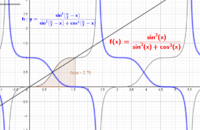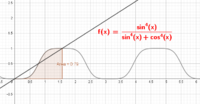You are using an out of date browser. It may not display this or other websites correctly.
You should upgrade or use an alternative browser.
You should upgrade or use an alternative browser.
Surprising result?
- Thread starter apple2357
- Start date
Dr.Peterson
Elite Member
- Joined
- Nov 12, 2017
- Messages
- 16,871
It looks to me like a matter of symmetry; the curve under which you are integrating is symmetrical about the point (pi/4, 1/2).
The area in each case is half of a rectangle with base pi/2 and height 1, because the curve bisects that rectangle. And that happens because f(pi/2 - x) = 1 - f(x).
The area in each case is half of a rectangle with base pi/2 and height 1, because the curve bisects that rectangle. And that happens because f(pi/2 - x) = 1 - f(x).
Dr.Peterson
Elite Member
- Joined
- Nov 12, 2017
- Messages
- 16,871
Yes, certain definite integrals are much easier than their indefinite integrals ...
I saw the answer purely visually; the last graph was most obvious, then I saw the symmetry in the others, and then I realized how to see that in the function itself. It's all about cofunctions.
I saw the answer purely visually; the last graph was most obvious, then I saw the symmetry in the others, and then I realized how to see that in the function itself. It's all about cofunctions.
I can see your transformations explanation works, i can't quite see why f(pi/2-x) is the same as f(x) but reflected in the way it is ( as below)
If it was f(x-pi/2) i would understand that as a simple translation but is f(pi/2-x) is a combination of transformations? Is this a translation and a reflection?

How did you come up with f(pi/2-x) = 1-f(x) as the explanation for the graphical observation?
If it was f(x-pi/2) i would understand that as a simple translation but is f(pi/2-x) is a combination of transformations? Is this a translation and a reflection?

How did you come up with f(pi/2-x) = 1-f(x) as the explanation for the graphical observation?
Dr.Peterson
Elite Member
- Joined
- Nov 12, 2017
- Messages
- 16,871
I'd call it a double reflection, first around x=pi/4 and then around y=1/2. Equivalently, and the way I described it initially, it is actually a rotation around the point (pi/4, 1/2). In the same way, reflecting in both y=0 and x=0 amounts to rotating by 180 degrees about the origin.
Replacing x with pi/2 - x reflects in x=pi/4, and replacing y with 1-y (that is, subtracting the result from 1) reflects in y=1/2. These are worth pondering until you see why!
Replacing x with pi/2 - x reflects in x=pi/4, and replacing y with 1-y (that is, subtracting the result from 1) reflects in y=1/2. These are worth pondering until you see why!
I'd call it a double reflection, first around x=pi/4 and then around y=1/2. Equivalently, and the way I described it initially, it is actually a rotation around the point (pi/4, 1/2). In the same way, reflecting in both y=0 and x=0 amounts to rotating by 180 degrees about the origin.
Replacing x with pi/2 - x reflects in x=pi/4, and replacing y with 1-y (that is, subtracting the result from 1) reflects in y=1/2. These are worth pondering until you see why!
So If we reflect y=f(x) in x=a, we get the curve y=f(−x+2a) ?
Is this because if you want to move every point to a position the same distance the other side of x=a we end up at x+2(a-x). Which gives us 2a -x
Is that how you would explain it?
Dr.Peterson
Elite Member
- Joined
- Nov 12, 2017
- Messages
- 16,871
Yes, that is one good way to explain this fact.
And, of course, the same fact is why the other reflection is 1 - y.
And, of course, the same fact is why the other reflection is 1 - y.







